#british slavery
Video
compensating British slave owners
United Kingdom finished paying off debts to slave-owning families in 2015
https://www.usatoday.com/story/news/factcheck/2020/06/30/fact-check-u-k-paid-off-debts-slave-owning-families-2015/3283908001/
https://www.ucl.ac.uk/lbs/project/details/
https://www.theguardian.com/world/2013/aug/27/britain-slave-trade
https://www.theguardian.com/world/2013/sep/01/cost-compensating-british-slave-owners
https://reparationscomm.org/reparations-news/britains-colonial-shame-slave-owners-given-huge-payouts-after-abolition/
#tiktok#chattel slavery#british slavery#slavery#slave trade#reperations#article#USA Today#tweet#tweets#twitter#colonization#colonialism#british imperialism#imperialism#slave owner#history#UK#united kingdom
93 notes
·
View notes
Text
The Zong affair
J.M.W. Turner took up a serious incident in 1840 and expressed it in a painting. The incident was the so-called Zong Affair, which changed the attitude towards the British slave trade.

The Slave Ship, by J.M.W. Turner, 1840 (x)
The Zong was until 1777 a Dutch slaver under the name Zorg and after her carpering she belonged to William Gregson and George Case, two well known merchants in the city of Liverpool and former mayors of the city. She sailed from the west coast of Africa on September 6, 1781 with 442 Africans bought as slaves on board, which made the ship completely overloaded and so she did not have sufficient supplies for such a large number of slaves. The poor people were chained in pairs, right leg and left leg, right hand and left hand, each of them having less space than a man in a coffin. The journey took nearly two months, and during that time most of the slaves were malnourished and suffering from disease. Captain Collingwood had lost his way in the Caribbean, which further prolonged the voyage. 60 slaves and 7 crew members had already died, and Collingwood knew that those who survived in poor condition would not fetch a high price on the slave market. He decided to use the lack of fresh water as an excuse to note that his "crew was endangered" to justify throwing 133 living slaves overboard. A reason that had a sinister background.
55 more were thrown overboard on November 29, and another 42 on November 30. A heavy rainstorm the following day provided fresh water, but another 26 slaves were thrown overboard that day, and another 10 jumped in to defy the captain, hugging each other as they sank. It was later claimed that the slaves were thrown overboard for the safety of the ship, as the ship did not have enough water to keep them alive for the rest of the voyage. This claim was later refuted as the ship still had 420 gallons (1910 liters) of water when it arrived in Jamaica on December 22. Let's move on to the reason why Captain Collingwood threw the people overboard alive. Behind it was an insurance policy. Because if a slave died on board, the insurers would not pay, seeing this as "poor cargo management." They would only pay the full sum insured if a slave went overboard alive. The owners demanded £30 per head from the insurers, which was disputed. The owners' lawyer argued, "These people are not charged with murder at all, there is not the slightest allegation”. After the insurers appealed, Lord Chief Justice Manfield upheld the shipowners: "The question left to the jury was whether it was necessary that the slaves should be thrown into the sea, for they had no doubt that the case of the slaves was the same as if horses had been thrown overboard." This ruling that removal was lawful led to a significant turning point in abolitionist campaigns.
The nondenominational Society for the Abolition of the Slave Trade was founded in 1787. The following year, Parliament passed the first law regulating the slave trade, the Slave Trade Act of 1788, to limit the number of slaves per ship. In 1791, Parliament prohibited insurance companies from compensating shipowners when enslaved Africans were murdered by being thrown overboard. A monument to enslaved Africans murdered on Zong was erected in Black River, Jamaica.
64 notes
·
View notes
Text
Bhavani Junction History Hollywood
Some time after entering Punjab University, when I started visiting the restaurants and tea houses of Pak Tea House and Pomegranate Village, Temple Road, Achhra, Nisib Road and Lakshmi, I met many people who were told about or had He himself said that he has worked with Eva Gardner in the English film “Bhavani Junction”. Then the stories of Eva Gardner’s beauty and beauty would be…

View On WordPress
#Actors#Amrooz#Ava Gardner#Ava Gardner and Stuart Granger#Baoji Sohni#Bhavani Junction#Bollywood#British Slavery#Director#Eva Gardner#Film Al-Leela#George Quacker#Hollywood#Hollywood movie#Lahore#Lahore Railway Station#Lahories#Lakshmi Mansion#Major Scenes#MGM#Mustansar Hussain Tarar#Neelu#Novel Rakh#Pakistani filmmakers#platform#Railway Station#Saqi#scandals#Sufiyan Afaqi
0 notes
Text
A very important video on the money Glasgow made from the empire and especially Scotland role in the slave trade
3K notes
·
View notes
Text
Had it not been for the steady stream of cheap raw cotton flowing out of the New World (which supplied nearly three-quarters of Britain’s imports of raw cotton), the British cotton industry would have never been able to play such a central role in Britain’s industrialisation. As David Washbrook notes, ‘[c]otton was exceptionally well-placed to lead the move towards mechanization: but favourably placed precisely because its raw material came from abroad’. That the British were able to outsource the production of raw cotton to the Americas – where the costs of production and labour in particular were considerably lower – was central to their industrial takeoff in the 18th century. Through the institution of the slave plantation in the colonies, capitalists were able to significantly reduce the costs of constant capital in the form of raw materials. Without this key input, it is highly unlikely British manufactures could have overcome the formidable competition from Indian cotton textiles, which even in the mid-18th century still held a leading position in world markets. The ‘workshop of the world’ was thus built on the foundations of plantation slavery.
Alexander Anievas and Kerem Nişancıoğlu, How the West Came to Rule: The Geopolitical Origins of Capitalism
105 notes
·
View notes
Text
Whenever Brits are like "tea is our national drink, our culture, our personality, our mental health" I think of our hill country blanketed in a patchwork quilt of human suffering and ongoing violent colonialism and want to smash all their tea cups. Your genocidal leaf juice is nothing to be proud of. The present day tea pluckers are the descendants of the Indians you enslaved and they still live in unthinkable poverty in the line houses you built to house them like cattle. The families whose farmlands you robbed have been starving for generations. Every sip of your leaf juice is soaked in blood and you drink it like vampires.
Tea will never belong to you. It's our legacy of grief, and your shame.

Drink your tea and shut the fuck up.
#sri lanka#'but my parents were immigrants!' 'and you're living in a genocidal country that's still sucking the marrow from the global south. so.'#'but my parents were indians!' 'ok? drink your chai and think about the stateless south indian tea pluckers? what is your point?'#if you live in britain you enjoy the fruits of its empire even if you're at the bottom of the food chain#that's why middle class Asians and Africans migrate to europe even if it means they have to earn a living on minimum wage#you can't share a race and country with sue braverman and tell me that your origins can make you any less complicit#british culture#tea#british empire#colonialism#british colonialism#colonization#extractive colonialism#tourism#capitalism#indigenous rights#indian ocean slavery#slavery#white supremacy#knee of huss#food culture#cash crops#monoagriculture#ecocide
47 notes
·
View notes
Text
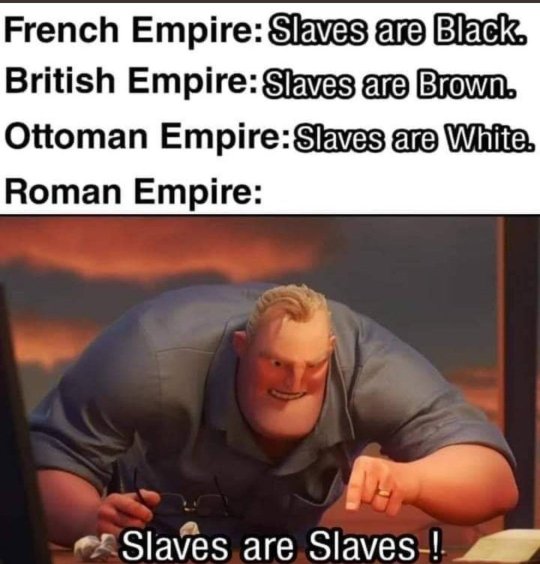
#meme#memes#dark humor#humor#funny humor#funny memes#funny#shitposting#shitpost#history#history memes#french empire#british empire#ottoman empire#roman empire#lmao#sarcasm#satire#irony#slavery
174 notes
·
View notes
Text
studying sociology of gender and u.s. history in the same quarter is going to be my villain origin story actually
#losing my faith in humanity as we speak.#personal#read about the entrenchment of slavery in the british colonies yesterday#read about patriarchy today#jesus.
28 notes
·
View notes
Note
Was the British Empire as a whole a slave society pre-1833?
Not really, no.
Slaves made up a relatively small percentage of the British Empire's population even in 1775, and while slavery absolutely contributed to Britain's economic development, slaveholding made up a small (although significant) percentage of the Empire's economy.
As a result, while there were powerful slave interests in both the economy and the political system, they weren't able to dominate the whole in the same way they did in the antebellum South. This in turn helps to explain why abolition movements were able to flourish and thus why the British government was willing to act against slavery at various times when it felt that was in its interests (although it was never quite the anti-slavery crusader it liked to portray itself as).
This is why I would describe the British Empire as a society with slavery rather than a slave society.
32 notes
·
View notes
Text
[T]he Dutch Republic, like its successor the Kingdom of the Netherlands, [...] throughout the early modern period had an advanced maritime [trading, exports] and (financial) service [banking, insurance] sector. Moreover, Dutch involvement in Atlantic slavery stretched over two and a half centuries. [...] Carefully estimating the scope of all the activities involved in moving, processing and retailing the goods derived from the forced labour performed by the enslaved in the Atlantic world [...] [shows] more clearly in what ways the gains from slavery percolated through the Dutch economy. [...] [This web] connected them [...] to the enslaved in Suriname and other Dutch colonies, as well as in non-Dutch colonies such as Saint Domingue [Haiti], which was one of the main suppliers of slave-produced goods to the Dutch economy until the enslaved revolted in 1791 and brought an end to the trade. [...] A significant part of the eighteenth-century Dutch elite was actively engaged in financing, insuring, organising and enabling the slave system, and drew much wealth from it. [...] [A] staggering 19% (expressed in value) of the Dutch Republic's trade in 1770 consisted of Atlantic slave-produced goods such as sugar, coffee, or indigo [...].
---
One point that deserves considerable emphasis is that [this slave-based Dutch wealth] [...] did not just depend on the increasing output of the Dutch Atlantic slave colonies. By 1770, the Dutch imported over fl.8 million worth of sugar and coffee from French ports. [...] [T]hese [...] routes successfully linked the Dutch trade sector to the massive expansion of slavery in Saint Domingue [the French colony of Haiti], which continued until the early 1790s when the revolution of the enslaved on the French part of that island ended slavery.
Before that time, Dutch sugar mills processed tens of millions of pounds of sugar from the French Caribbean, which were then exported over the Rhine and through the Sound to the German and Eastern European ‘slavery hinterlands’.
---
Coffee and indigo flowed through the Dutch Republic via the same trans-imperial routes, while the Dutch also imported tobacco produced by slaves in the British colonies, [and] gold and tobacco produced [by slaves] in Brazil [...]. The value of all the different components of slave-based trade combined amounted to a sum of fl.57.3 million, more than 23% of all the Dutch trade in 1770. [...] However, trade statistics alone cannot answer the question about the weight of this sector within the economy. [...] 1770 was a peak year for the issuing of new plantation loans [...] [T]he main processing industry that was fully based on slave-produced goods was the Holland-based sugar industry [...]. It has been estimated that in 1770 Amsterdam alone housed 110 refineries, out of a total of 150 refineries in the province of Holland. These processed approximately 50 million pounds of raw sugar per year, employing over 4,000 workers. [...] [I]n the four decades from 1738 to 1779, the slave-based contribution to GDP alone grew by fl.20.5 million, thus contributing almost 40% of all growth generated in the economy of Holland in this period. [...]
---
These [slave-based Dutch commodity] chains ran from [the plantation itself, through maritime trade, through commodity processing sites like sugar refineries, through export of these goods] [...] and from there to European metropoles and hinterlands that in the eighteenth century became mass consumers of slave-produced goods such as sugar and coffee. These chains tied the Dutch economy to slave-based production in Suriname and other Dutch colonies, but also to the plantation complexes of other European powers, most crucially the French in Saint Domingue [Haiti], as the Dutch became major importers and processers of French coffee and sugar that they then redistributed to Northern and Central Europe. [...]
The explosive growth of production on slave plantations in the Dutch Guianas, combined with the international boom in coffee and sugar consumption, ensured that consistently high proportions (19% in 1770) of commodities entering and exiting Dutch harbors were produced on Atlantic slave plantations. [...] The Dutch economy profited from this Atlantic boom both as direct supplier of slave-produced goods [from slave plantations in the Dutch Guianas, from Dutch processing of sugar from slave plantations in French Haiti] and as intermediary [physically exporting sugar and coffee] between the Atlantic slave complexes of other European powers and the Northern and Central European hinterland.
---
Text above by: Pepijn Brandon and Ulbe Bosma. "Slavery and the Dutch economy, 1750-1800". Slavery & Abolition Volume 42, Issue 1. 2021. [Text within brackets added by me for clarity. Bold emphasis and some paragraph breaks/contractions added by me. Presented here for commentary, teaching, criticism purposes.]
#abolition#these authors lead by pointing out there is general lack of discussion on which metrics or data to use to demonstrate#extent of slaverys contribution to dutch metropolitan wealth when compared to extensive research#on how british slavery profits established infrastructure textiles banking and industrialisation at home domestically in england#so that rather than only considering direct blatant dutch slavery in guiana caribbean etc must also look at metropolitan business in europe#in this same issue another similar article looks at specifically dutch exporting of slave based coffee#and the previously unheralded importance of the dutch export businesses to establishing coffee mass consumption in europe#via shipment to germany#which ties the expansion of french haiti slavery to dutch businesses acting as intermediary by popularizing coffee in europe#which invokes the concept mentioned here as slavery hinterlands#and this just atlantic lets not forget dutch wealth from east india company and cinnamon and srilanka etc#and then in following decades the immense dutch wealth and power in java
24 notes
·
View notes
Photo
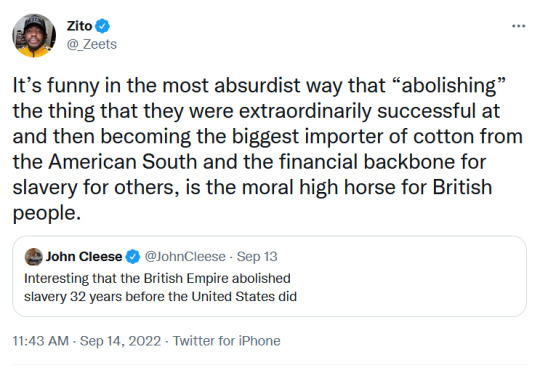
#tweet#tweets#twitter#history#british royal family#british history#chattel slavery#american civil war#american slavery#slavery#british slavery
3 notes
·
View notes
Text
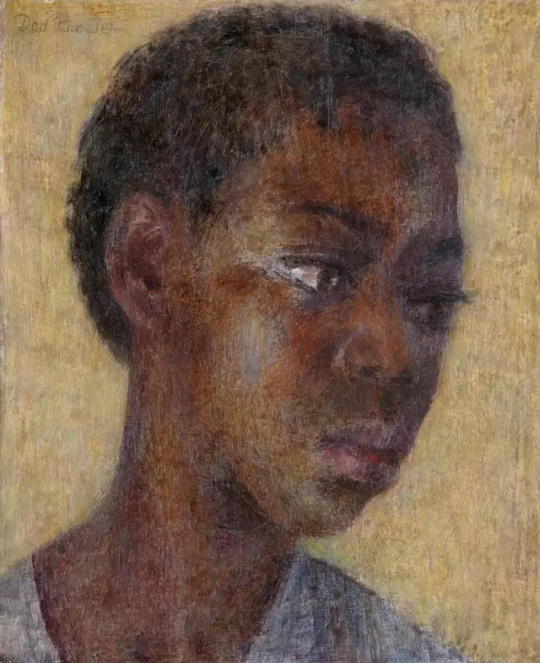
Jamaican Girl, ca. 1956-60
Dod Procter RA (1891 - 1972)
RA Collection: Art
Procter travelled widely, and had already visited Asia, Africa and North America before she began regularly visiting Jamaica during the 1950s. She painted many portraits of Jamaican children during her stays, including this portrait which the RA purchased after it was shown in the 1960 Summer Exhibition.
Procter painted Jamaican Girl in the late 1950s, at a time of increased tensions surrounding the growing black presence in Britain and increasing momentum towards Jamaican independence. None of this, however, is registered in the pensive face of Jamaican Girl.
#black woman#black beauty#beauty#natural hair#dark skin#black history month#british history#jamaican history#slavery#transatlantic slavery#human atrocity#delicate#dod procter#dod procter ra#black british#colonisation
43 notes
·
View notes
Text
Britain Lavender Mafia








In the British Lavender Mafia, those in a higher tier of society will usually strong-arm, trick or coerce new and younger artists in the industry, to take over their career, bleed them dry, pimp them out, and not just for sex. Sometimes, it may be for torture. They'll use the artists for everything, from getting attention for a project, asset collecting, and often, SPYING. Sometimes, the artist is SOLD as a child, to a wealthier family, according to Freemason laws. Yes. Freemasons buy and sell their children to each other. This is usually tied to Occult activity.

Special mention goes to Dakota Johnson for agreeing to spy on an old friend for Dorman in exchange for a part in a Kenneth Branagh film.
#Blackmail#Embezzlement#Sex Trafficking#Occultism#THIS WILL STAY UP AND WILL BE ADDED TO#Peter Mandelson#Russell T Davies#Eddie Redmayne#Jamie Dorman#Mark Gatiss#Cillian Murphy#Graham Norton#Dakota Johnson#Spying#Kompromat Collecting#MKULTRA#Freemasonry#Slavery In The British Film Industry#BBC#Modern Day Slavery#Anti Neil Gaiman#Scientology#Barry Keoghan#Andrew Scott#Cody Fern#Balenciaga/Baalenciaga#Andrew Garfield#Daniel Craig
15 notes
·
View notes
Text
While enslaved people were mostly overseas, in colonies, out of sight, slavery funded British wealth and institutions from the Bank of England to the Royal Mail. The extent to which modern Britain was shaped by the profits of the transatlantic slave economy was made even clearer with the launch in 2013 of the Legacies of British Slave-ownership project at University College London. It digitised the records of tens of thousands of people who claimed compensation from the government when colonial slavery was abolished in 1833, making it far easier to see how the wealth created by slavery spread throughout Britain after abolition. “Slave-ownership,” the researchers concluded, “permeated the British elites of the early 19th century and helped form the elites of the 20th century.” (Among others, it showed that David Cameron’s ancestors, and the founders of the Greene King pub chain, had enslaved people.)
But as Bell-Romero would write in his report on Caius, “the legacies of enslavement encompassed far more than the ownership of plantations and investments in the slave trade”. Scholars undertaking this kind of archival research typically look at the myriad ways in which individuals linked to an institution might have profited from slavery – ranging from direct involvement in the trade of enslaved people or the goods they produced, to one-step-removed financial interests such as holding shares in slave-trading entities such as the South Sea or East India Companies.
Bronwen Everill, an expert in the history of slavery and a fellow at Caius, points out “how widespread and mundane all of this was”. Mapping these connections, she says, simply “makes it much harder to hold the belief that Britain suddenly rose to power through its innate qualities; actually, this great wealth is linked to a very specific moment of wealth creation through the dramatic exploitation of African labour.”
This academic interest in forensically quantifying British institutions’ involvement in slavery has been steadily growing for several decades. But in recent years, this has been accompanied by calls for Britain to re-evaluate its imperial history, starting with the Rhodes Must Fall campaign in 2015. The Black Lives Matter protests of 2020 turbo-charged the debate, and in response, more institutions in the UK commissioned research on their historic links to slavery – including the Bank of England, Lloyd’s, the National Trust, the Joseph Rowntree Foundation and the Guardian.
But as public interest in exploring and quantifying Britain’s historic links to slavery exploded in 2020, so too did a conservative backlash against “wokery”. Critics argue that the whole enterprise of examining historic links to slavery is an exercise in denigrating Britain and seeking out evidence for a foregone conclusion. Debate quickly ceases to be about the research itself – and becomes a proxy for questions of national pride. “What seems to make people really angry is the suggestion of change [in response to this sort of research], or the removal of specific things – statues, names – which is taken as a suggestion that people today should be guilty,” said Natalie Zacek, an academic at the University of Manchester who is writing a book on English universities and slavery. “I’ve never quite gotten to the bottom of that – no one is saying you, today, are a terrible person because you’re white. We’re simply saying there is another story here.”
321 notes
·
View notes
Text
K. J. CHARLES, I LOVE YOU.
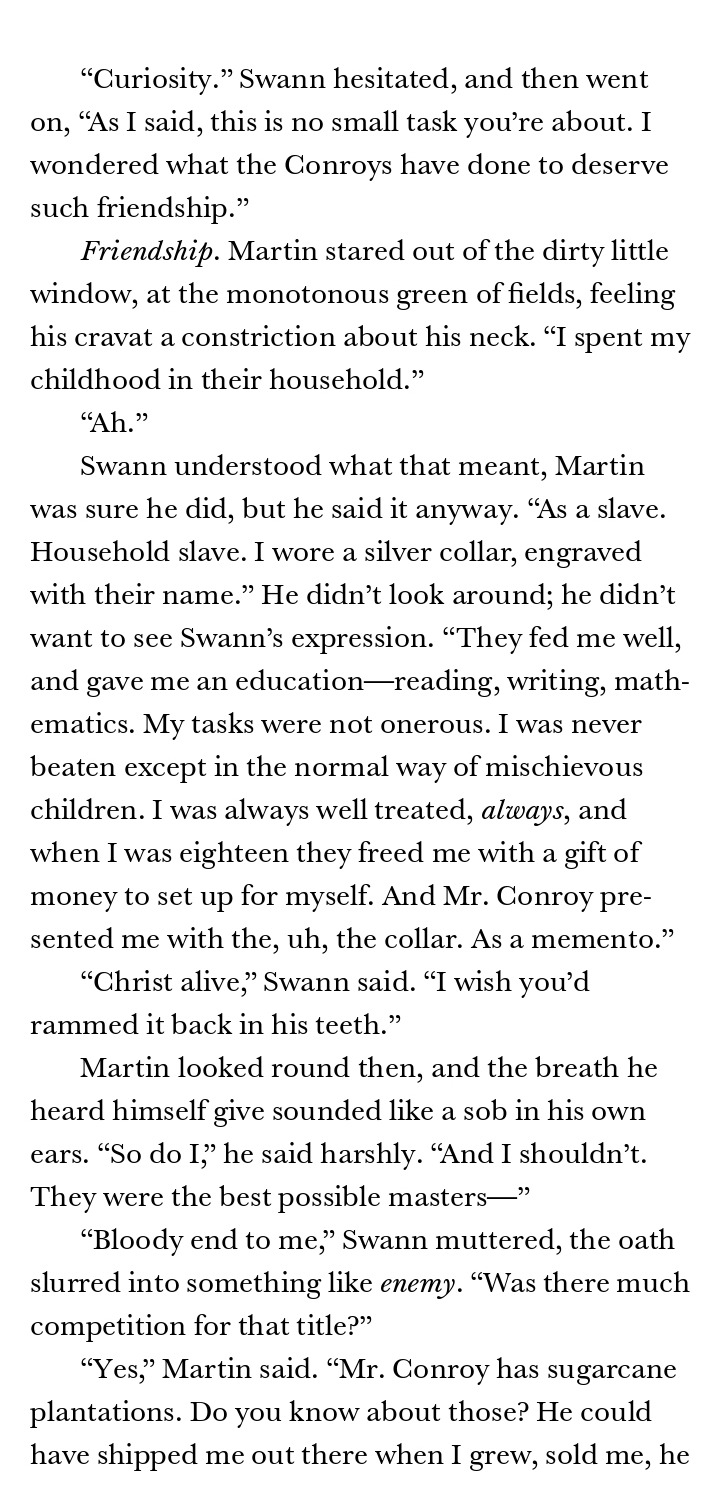
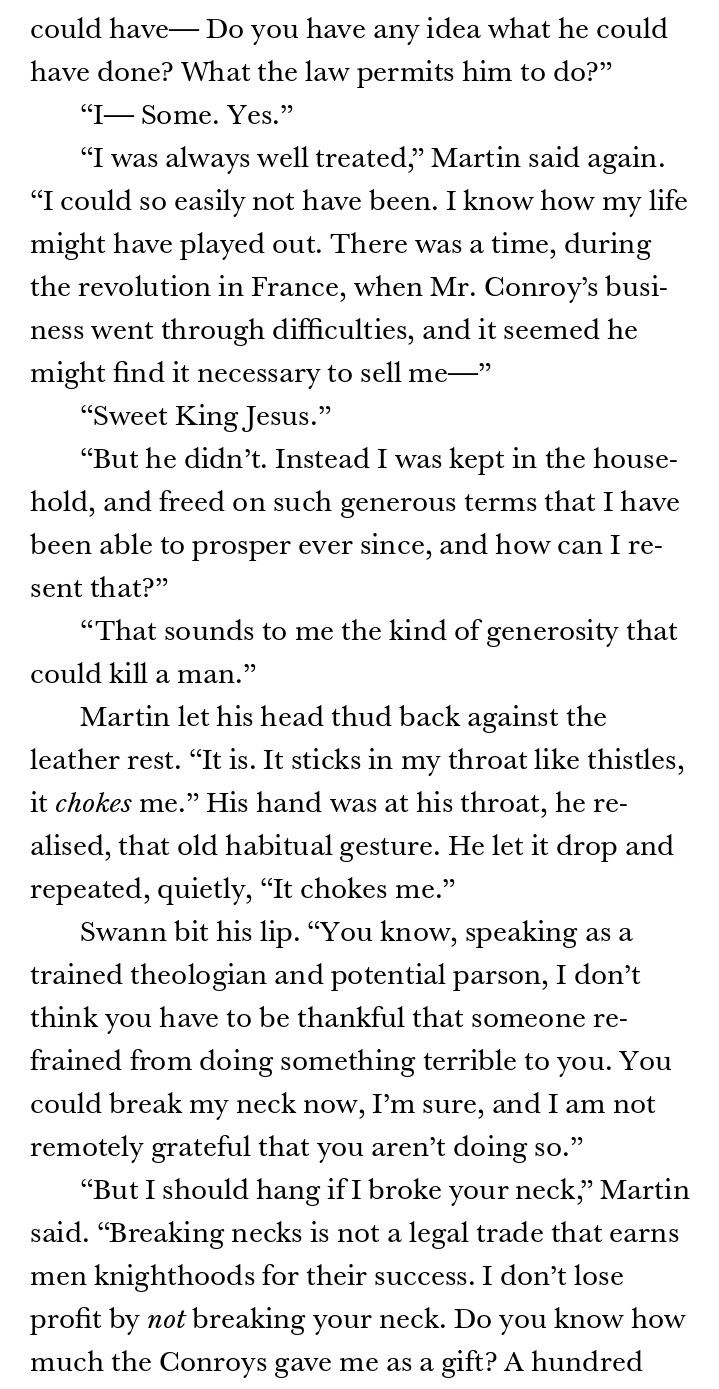

...


— Wanted: A Gentleman, K. J. Charles (2017)
That's the emotional thread that runs through the whole novella, coupled with his conflicted love for the Conroys' daughter he helped raise. It runs in parallel with Swann's own shackles of ursury and exploitation, which, while not comparable with Martin's bondage, still inspires his empathy and compassion.
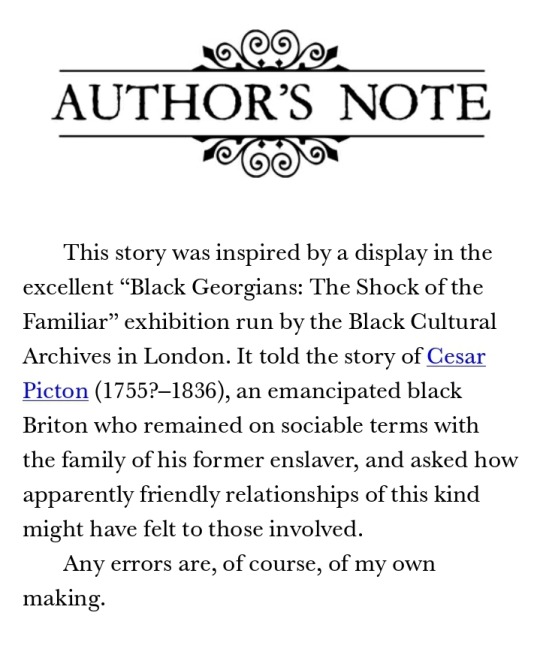
Cesar Picton
Black Georgians: The Shock of the Familiar
FUCK YOUR BRIDGERTON-ASS WHITE LIBERAL DIVERSITY-COOKIES REPRESENTATION. THIS IS HOW YOU WRITE BLACK AND BROWN PEOPLE. We've always been here, bitch. Pay attention and be curious about our interiority for once.
#she's so confident writing characters of colour and their struggles#i wish she'd include a little bit of their culture as well but the fact that they've assimilated into whiteness so much#while never being accepted as fully british is a big part of it#mimi matthews does a slightly better job but she doesn't have as many black characters and she's not this polished and clever#she's quarter indian though#kj charles#wanted a gentleman#black british history#queer historical romance#interracial romance#writing diversity#black representation#black history#slavery#anti blackness#british history#book recommendations#book recs#knee of huss
17 notes
·
View notes
Text

Having a monarchy next door is a little like having a neighbour who’s really into clowns and has daubed their house with clown murals, displays clown dolls in each window and has an insatiable desire to hear about and discuss clown-related news stories.
More specifically, for the Irish, it’s like having a neighbour who’s really into clowns and, also, your grandfather was murdered by a clown.
— Patrick Freyne, The Irish Times
19 notes
·
View notes